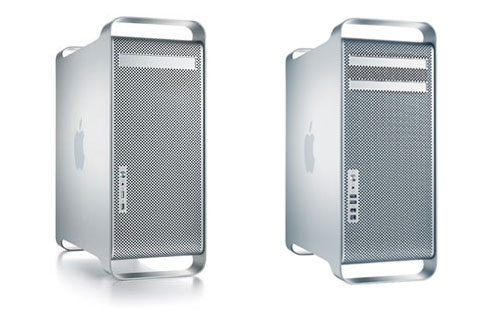Hosted by site sponsor WebMate.
Silver Tower Mac Pro (Dual Optical) Q&A - Published August 8, 2006
All Mac Q&As >> Silver Tower Mac Pro Dual Optical Q&A (Home)
To be notified of new Q&As, sign up for EveryMac.com's bimonthly email list.
What are the major differences between the original Mac Pro and the Power Macintosh G5?
Please note that all systems mentioned in this Q&A have been discontinued. The original Mac Pro models were replaced on January 8, 2008 by the "Early 2008" Mac Pro models.
As there are a large number of models in the Power Macintosh G5 series with widely differing capabilities, it probably is easiest to compare the Mac Pro Quad 2.66 to its immediate predecessor, the Power Macintosh G5 Quad 2.5.

Photo Credit: Apple Computer
Upon first glance, it would be easy to mistake the two (the Power Mac G5 is on the left and the Mac Pro is on the right). Upon inspection, however, one would notice that the Mac Pro has an extra 5.25" drive bay and a headphone jack, two USB 2.0 ports, one Firewire "400", and one Firewire "800" port on the front, compared to a front-mounted headphone jack, single USB 2.0 port, and single Firewire "400" port on the Power Macintosh G5.
Flip the systems around and you would find that both have dual DVI ports (one single link and one dual link), a single Firewire "400" and single Firewire "800" port, dual Gigabit Ethernet ports, analog stereo line-level input and output minijacks, and optical digital audio input and output ports. The only rear connectivity difference is that the Power Macintosh G5 has two USB 2.0 ports and the Mac Pro has three. AirPort Extreme (802.11g), Bluetooth 2.0+EDR, and an external modem are options for both systems.
Review the technical specifications, however, and it becomes immediately clear that the Power Macintosh G5 and Mac Pro are completely different animals. The Power Macintosh G5 is powered by two dual core 2.5 GHz PowerPC 970MP (G5) processors with four optimized AltiVec "Velocity Engine" vector processing units (one per core), eight "double-precision" FPUs (two per core), 1 MB of on-chip level 2 cache on each core (four total), and a 1.25 GHz frontside system bus. The stock Mac Pro, on the other hand, is powered by two dual core Intel Xeon 5150 processors with 4 MB of shared level 2 cache per processor, a 128-bit SSE3 vector engine, and 1.33 GHz "64-bit dual independent frontside buses."
The Mac Pro uses faster 667 MHz DDR2 ECC "fully-buffered" FB-DIMM memory compared to 533 MHz DDR2 SDRAM (PC2-4200) for the Power Macintosh G5. Both systems have eight RAM slots and can support up to 16 GB of RAM. The Mac Pro, by default, is configured with a NVIDIA GeForce 7300 GT with 256 MB of GDDR2 SDRAM and the Power Macintosh G5 shipped with a NVIDIA GeForce 6600 video card with 256 MB of GDDR SDRAM. Both systems have three free PCI-Express slots (with one video card installed).
Perhaps most notably, the Mac Pro offers substantially more internal drive bays -- two 5.25" drive bays compared to one in the Power Macintosh G5, as previously mentioned, and four 3.5" drive bays, supporting two more drives than the Power Macintosh G5 can support without third-party modification. The Mac Pro offers support for faster drives as well -- 3 Gb/s Serial ATA compared to 150-MBps Serial ATA for the Power Mac G5. The Mac Pro also has a sleek drive carrier system that makes it easy to "slide [drives] simply into place" without a cable and a "latch [that] locks them securely into the enclosure". The optical drives are identical -- 16X SuperDrives "with dual layer support" capable of writing DVD-R at 16X and DVD+R DL at 6X.
In general, the Mac Pro offers faster processors, a faster architecture, and more features. Exactly what you would expect in a new system regardless of the processor type used. Most impressively, however, the standard configuration of the Mac Pro was US$800 less than the Power Macintosh G5.
In the US, site sponsor OWC sells used Mac Pro models at affordable prices.
Please refer to EveryMac.com's Ultimate Mac Comparison feature to dynamically compare any Mac Pro model to any other G3 or later Mac.
Permalink | Report an Error/Typo | Sign Up for Site Update Notices
<< Mac Pro Dual Optical Drives Q&A (Main) | All Mac Q&As
Established in 1996, EveryMac.com has been created by experts with decades of experience with Apple hardware. EveryMac.com includes, and always has included, original research incorporating detailed, hands-on inspection of packaging, computers, and devices as well as extensive real-world use. All information is provided in good faith, but no website or person is perfect. Accordingly, EveryMac.com is provided "as is" without warranty of any kind whatsoever. EveryMac.com, and the authors thereof, shall not be held responsible or liable, under any circumstances, for any damages resulting from the use or inability to use the information within. For complete disclaimer and copyright information please read and understand the Terms of Use and the Privacy Policy before using EveryMac.com. Copying, scraping, or use of any content without expressed permission is not allowed, although links to any page are welcomed and appreciated.
